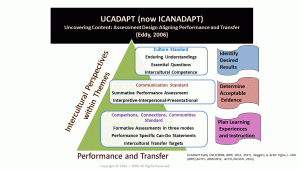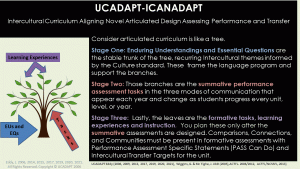ICANADAPT is Intercultural Curriculum Aligns Novel Assessment Design Articulated Performance and Transfer (Eddy, 2006, 2007, 2010, 2014, 2015, 2017, 2019, 2020, 2022) is a curriculum design model created for world languages, K-16. This ICANADAPT online thematic unit design framework and template is developed from the original design model, UCADAPT (Uncovering Content: Assessment Design Aligning Performance and Transfer (US Copyright, 2006). From 2004-2020, Dr. Jennifer Eddy presented this design framer and unit templates to world language educators at ACTFL, NALRC, NECTFL, NYSAFLT, NYCAFLT, FLENJ, MaFLA, NCLC, STARTALK, NCOLCTL, NFLRC, CALPER, NCLRC, AATSP, and for professional development for many school districts, state education departments, and universities as early as 2004. The design has been published throughout various multimedia. This protocol is used at Queens College, CUNY teacher certification program in world language curriculum and assessment design. The logo below was specifically designed for UCADAPT/ICANADAPT by Dr. Eddy to add additional recognition and to remember this alignment of the national standards with Backward Design/UbD.


Using our DesignSpace Tools, a teacher can design: Stage 2 articulated assessment design across any three target levels of learner engagement as AATT (Articulated Assessment Transfer Task)
Intercultural Curriculum Aligns Novel Assessment Design Articulated Performance and Transfer (ICANADAPT) Units unpack one target level of the AATTs into a full unit, with formative assessment tasks at lesson level for Stage 3 in this UbD framework. See the exemplars below, make a profile, and use the tools to design units for transfer in an articulated curriculum.
A full thematic unit with ICANADAPT. UCADAPT was the first to align UbD/backward design to the 5Cs for world language curriculum development in a formalized way and to operationalize Culture, specifically intercultural perspectives as the overarching framer for world language curriculum. UCADAPT, now ICANADAPT design model reveals cultural practices and perspectives within recurring themes, using them to align performance assessment evidence and transfer of knowledge and skills to novel contexts and situations across content areas. This design model has adapted with ongoing innovations to the national standards. The latest iteration is ICANADAPT (2017, 2019, 2020.) UCADAPT/ICANDAPT aligns the three stages of Understanding by Design (Mc Tighe & Wiggins, 2001/2005/2012) and the National Standards for Foreign Language Learning (ACTFL 1996/2014). This model addresses the five goal areas and facilitates design of performance-based assessments using cultural themes that are recursive and reflective, using a unique framework based on backward design and the communicative modes for the assessment system. By uncovering cultural perspectives within global themes and disciplines to write Enduring Understandings and Essential Questions in stage one, the learner is able to address big ideas essential to intercultural competence. These themes become more accessible, personalized, and equitable to all learners of a language. This model includes designing assessment tasks for transfer across content areas, showing flexibility and critical thinking skills rather than fact-based or rote measures of knowledge.
References
The DesignSpace is supported by private funding.
